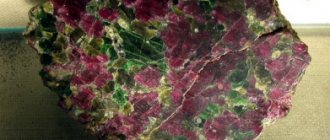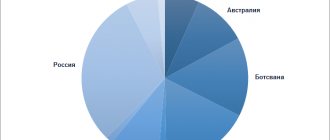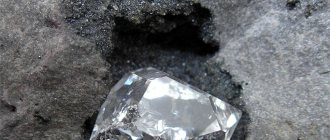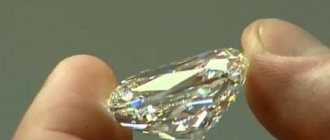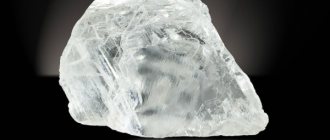The Diamond Fund of Gokhran has such an exhibit - a map of Russia, made entirely of diamonds. It’s unbearable to look at, not so much because of its kitsch, but because of its powerful shine. If you believe the statistics of Alrosa, which reports that almost 90% of the diamonds present on the world market are mined in the Russian Federation, then the logic of the authors of this map is clear. If you delve into the essence, it becomes clear that Russia should be a black spot on the diamond map of the world. The Russian diamond market doesn't seem to be a very fun place. Yana Raskovalova, owner of the Yana brand, one of the few Russian jewelry brands that is interesting to foreign buyers, thinks so. Both she and Aksenov, without saying a word, admit: “The problem is that the industry was killed by the Soviet regime.” Perhaps the decline in any industry can be explained by the rise of socialism, which ended, according to some, in “the greatest geopolitical catastrophe of the century,” but both jewelers say that this skating rink was especially harsh in their field. “Actually, for whom should jewelry exist in the USSR?” – Aksenov asks a rhetorical question. Raskovalova nods: “Someone was killed, someone left for other countries. While the jewelry industry was developing all over the world, we stood still.”
History of diamond mining in Russia
The first precious stones were discovered during the development of gold mines during the process of washing the soil. However, in the 19th century, no attention was paid to the issue of financing the exploration of diamond deposits, because the discovered stones were small, piecemeal and did not provide prospects for investment.
- The first diamond crystal discovered on the territory of the Russian Empire dates back to July 4, 1829.
- The diamond, first recovered from Siberian lands, dates back to November 1897.
- The third stone was discovered in Siberia only 51 years later, in 1948.
The catalyst for the active development of the industry and the start of exploration work was the Cold War. If previously the USSR purchased rough diamonds from Great Britain, which was developing mines in African colonies, then with the onset of a crisis in diplomatic relations, the British stopped selling precious stones to our country. There is a need to look for our own resources.
The geological structure of the subsoil in the territory of Yakutia turned out to be similar to the South African territories. The search began on the Chona and Vilyui rivers.
- On August 7, 1949, the first diamond was found on the Sokolinaya sand spit, and a diamond placer was also discovered here.
- In the period 1950-1953, several more placers were found.
- The first Zarnitsa kimberlite pipe, discovered in August 1954, was insufficient for industrial scale development.
- On June 13, 1955, a kimberlite pipe was discovered, which later became known as “Mir”. The weight of diamonds in the mine was 5 carats, or 1 gram. This meant serious potential for industrial development.
Reproduction of the diamond raw material base
In Russia, geological exploration for diamonds is carried out annually. In 2022, two alluvial objects were put on the State Balance Sheet of Mineral Reserves of the Russian Federation for the first time: the river. Billyakh (tributaries) and stream. Ochuos. A significant increase in reserves of categories A+B+C1 was obtained on the placers of the stream. Lyaseger-Yuryakh and Nyurbinskaya, as well as the Yubileinaya pipe. The total increase in diamond reserves of categories A+B+C1 due to exploration amounted to 7.3 million carats.
The bulk of diamond exploration is provided by ALROSA Group companies. In 2018-2019, additional exploration of the Yubileinaya and Zarnitsa pipes was carried out, work was carried out at the placer deposits of the Anabar and Prilensky diamond-bearing regions (Mal Kuonamka and Maspaki, Molodo, Mayat rivers, Balagannakh stream, etc.).
Early stage exploration (prospecting and evaluation) aimed at identifying new kimberlite fields and diamond deposits is also mainly carried out by ALROSA Group enterprises in the Republic of Sakha (Yakutia) and the Arkhangelsk region. In addition, prospecting for diamonds is carried out by the companies AGD DIAMONDS JSC and Proex Service LLC in the Arkhangelsk region, Almining LLC in the Perm Territory, Diamant LLC in the Leningrad region and others.
In total, in 2022, subsoil users spent 5.2 billion rubles on geological exploration (GE), 13% less than in 2022. Despite significant investments, the growth rate of diamond reserves in Russia is generally low. Over the past decade, they have only twice exceeded their loss in production: in 2009 (based on the results of additional exploration of the Internatsionalnaya and Nyurbinskaya pipes) and in 2016 (exploration of the deep horizons of the Aikhal pipe, revaluation of reserves of the Verkhne-Munskoye field)
Diamond mining process
Placers are developed using butar scrubbers, less often - pebble mills. This is due to the fact that the components are in a free state. At the same time, it is important to process the ore carefully so as not to damage the precious crystals. The average content in developed placers is usually not lower than 0.1 carat/m3.
Kimberlite pipes are primary deposits. Pillars or cones go deep into the depths. The diameter of the tubes varies from 40 to 60 meters. The tube can stretch up to a kilometer deep.
First, a kimberlite pipe is mined using an open pit method. The soil is crushed, loaded into heavy dump trucks and sent for processing. In permafrost areas, blasting is used to break through to diamond-enriched rock and be able to load it in and out of the quarry.
Water and oil may seep into the bottom of the quarry; pumping must be carried out in a timely manner so that the loading equipment can continue to operate. The Mirny quarry was openly mined to a level of 525 meters, and the serpentine along which heavy dump trucks transported rock stretched for 8 kilometers.
Below the 600-meter mark, diamond pipes are not mined by open-pit mining. They are preserved and then the feasibility of constructing a mine is decided.
Diamond mining in mines is of a closed type. This is a complex technical object with life support systems that allows people to stay at great depths for a long time. The tunnel goes to a depth of 500–1000 meters, industrial infrastructure is built in it - elevators, ventilation and water supply systems, and highways are provided for transport, trolleys transporting ore, bulldozers and drilling machines.
[edit] Notes
- Smolensk Kristall has reduced its diamond production by a third. February 19, 2014
- Story
- Diamond production in Russia. March 29, 1995
- Diamond production in Russia. March 29, 1995
- Diamond production in Russia. March 29, 1995
- Spending is on the verge. Why Russian diamonds are highly valued on world markets. June 28, 2011
- About company
- Annual report "PO Kristall" for 2013
- Smolensk Kristall has reduced its diamond production by a third. February 19, 2014
- Annual report 2013
- Diamond making
- Annual report 2013
- Diamond making
- Alrosa will share diamonds. September 26, 2014
- Alrosa will share diamonds. September 26, 2014
- Alrosa will share diamonds. September 26, 2014
- Spending is on the verge. Why Russian diamonds are highly valued on world markets. June 28, 2011
Source - ""
Categories: Russian manufacturing industries | Diamonds
The largest diamond deposits in Russia
- “Yubileiny” is an open-pit mine, with a projected development depth of up to 720 meters; the mark of 320 meters has now been reached. The preliminary estimate of the quarry's potential is 153,000,000 carats.
- “Udachny” - the mine’s reserve potential is estimated at 152,000,000 carats.
- "Mir" is also being developed using the shaft method. 141,000,000 carats—total reserves of the quarry, according to expert estimates.
- Botoubinskaya: production forecast - 71,000,000 carats. The kimberlite pipe has been developed recently, but has industrial potential for several decades.
Structure of the diamond industry of the Russian Federation
The company PJSC Severalmaz, operating in the Arkhangelsk region, at the end of 2022 began mining ore at the pipe named after. Karpinsky 2 from the group of deposits named after. M.V. Lomonosov, which is planned to be developed in a single quarry with the developed pipe named after. Karpinsky 1. It is assumed that on the basis of the Arkhangelsk pipe reserves, named after. Karpinsky 1 and im. Karpinsky 2, the enterprise will operate for another 29 years. In the long term, Severalmaz PJSC plans to put into operation the remaining pipes of the group of fields named after. M. V. Lomonosov: im. Lomonosov, Pionerskaya and Pomorskaya.
ALROSA Group is also implementing several projects for the development of alluvial deposits in the Republic of Sakha (Yakutia), the largest of which is Solur-Vostochnaya.
The first diamond in the Russian Federation
A teenage serf, washing ore in the Adolfovsky log of the Krostovozdvizhensky gold mines, discovered a crystal that brought him freedom. 192 years have passed since the discovery of the first diamond in the history of the Russian Empire.
A diamond weighing 342.5 carats, named “XXVI Congress of the CPSU,” became the first crystal by weight in the history of the USSR diamond industry. He was found at the Mir mine.
In 2012, a 79.9-carat stone was found there, which became the largest in the history of modern Russian diamond mining. Diamond is called "President".
[edit] Russian cut
The “Russian cut” developed in the 1970s. The USSR authorities paid great attention to the development of the diamond cutting industry. The Soviet economy demanded that all the best be exported. Accordingly, export additions were made to the quality criteria of any product. And these export conditions required that the diamond should not have even the slightest defects. If a diamond had a small chip or nick, it was necessary to polish it to such a state that everything would be smoothed out. And the result was a truly impeccable quality of cutting and polishing of the diamond, but at the expense of its mass. Masters of the Belgian and Israeli schools do not act this way.[17]
Yakutalmaz
In 1957, in order to successfully develop mining operations for the extraction of rough diamonds, on the territory of the tent village “Mirny”, the Yakutalmaz trust was created. The organizers were faced with the most difficult conditions in the taiga, frosts down to -60 degrees, and the need to work in permafrost conditions in the absence of infrastructure.
- 1961 – the Aikhal pipe was opened;
- 1969 – work began on the International tube.
An underground nuclear explosion was used to open about 15 pipes between 1970 and 1980. In Mirny, during the same period, geologists opened the world’s only museum of kimberlites, where private collections of researchers were initially provided.
State and prospects for development of the diamond industry
In 2022, 24 diamond deposits were developed in Russia, including 13 primary and 11 placer diamonds. 42.9 million carats of diamonds were extracted from the depths of the country. Diamond mining is carried out only in two regions: the Republic of Sakha (Yakutia) and the Arkhangelsk region. In the Republic of Sakha (Yakutia), which provides 77% of the domestic production of precious stones, the country's largest primary (Yubileinaya, Udachnaya, etc. pipes) and alluvial (Ebelyakh, Nyurbinskaya placer) deposits are being developed. The rest of Russian diamonds are mined in the Arkhangelsk region at two pipes of the group named after. M.V. Lomonosov and the tube named after. V. Grib.
The main volume of diamond production in Russia is provided by the ALROSA Group, which directly includes AK ALROSA (PJSC), as well as PJSC Severalmaz and JSC Almazy Anabara. Another company that is part of the ALROSA structure, PJSC ALROSA-Nyurba, has been in the process of liquidation since the fall of 2022. ALROSA Group enterprises develop all fields of the Republic of Sakha (Yakutia) and the group’s facilities named after. M.V. Lomonosov in the Arkhangelsk region. The structure of the ALROSA Group includes six production complexes that mine and process diamond-containing ores and sands: Aikhal, Nyurbinsky, Mirninsky, Udachninsky and Lomonosovsky GOKs, as well as the mining and processing complex of JSC Almazy Anabara. Primary deposits are developed by open pit and underground methods, placer deposits by open pit and dredge. Processing of ores and sands is carried out at processing plants at mining and processing plants, as well as seasonal sorting and processing factories (placer sands developed by Almazy Anabara JSC). In 2018, ALROSA Group enterprises produced 38.1 million carats. All of the company's developed fields were exploited, with the exception of the Mir pipe, the work of the underground mine at which was stopped due to an accident that occurred in August 2022.
The only diamond mining company in Russia that is not part of the ALROSA structure is AGD DIAMONDS JSC, which is part of Otkritie Holding JSC and operates the pipe named after. V. Grib in the Arkhangelsk region, processing ores at the processing plant of the mining and processing plant of the same name.
Due to the fact that almost all significant diamond deposits in Russia have already been put into production, the prospects for increasing the extraction of stones are small.
In October 2022, AK ALROSA (PJSC) brought into commercial production the Verkhne-Munskoye field, beginning open-pit development of the Polar Pipe. The deposit will be developed by two quarries with a total productivity of 3 million tons of ore per year (about 1.9 million carats of diamonds) with the involvement of four of the five kimberlite pipes included in it (Zapolyarnaya, Deimos, Novinka, Komsomolskaya-Magnitnaya). Reaching full design capacity is expected in 2024, the life of the mine will be 25 years. The mined ores are transported by road trains to the Udachny Mining and Processing Plant for processing.
In April 2022, AK ALROSA (PJSC), using the Aikhal Mining and Processing Plant, began mining ore at the Zarya kimberlite pipe, which should compensate for the retiring capacity of the Komsomolskaya pipe. During the year it was planned to extract 100 thousand tons of ore, and in 2022 to reach full design capacity - 1.25 million tons (about 355 thousand carats of diamonds). The development of the quarry to a depth of 300 m was planned to take place over 11 years. However, in May 2020, mining operations at the Zarya pipe (as well as at the Aikhal underground mine) were suspended due to a drop in demand for diamonds on the world market caused by the COVID-19 pandemic.
The Mayskoye indigenous deposit and the associated placer of the same name are located in the area of operation of the Nyurbinsky mining and processing plant. AK ALROSA (PJSC) planned to begin construction of the quarry in 2022, and in 2025 to put these facilities into development with full capacity (300 thousand tons of ore and sand) in 2027. The mine life of the deposits will be 15 years.
